UiPath Bundle
Who Really Owns UiPath?
Ever wondered who truly calls the shots at UiPath, a global leader in robotic process automation? Understanding the UiPath SWOT Analysis is key to grasping its market position. This exploration dives deep into the company's ownership structure, a critical factor influencing its future trajectory and strategic decisions. From its founding to its IPO and beyond, we'll uncover the key players shaping UiPath's destiny.
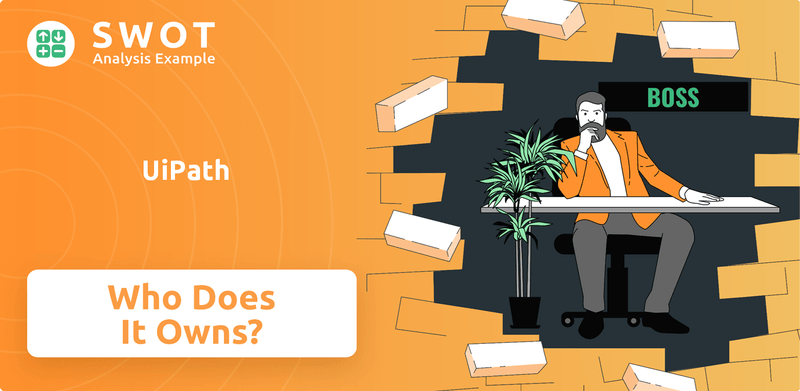
The journey of the UiPath company, from a Romanian startup to a publicly traded giant, is a testament to its innovative approach to automation. The shift from private to public ownership, marked by its IPO in April 2021, significantly altered the landscape, introducing new investors and influencing the company's direction. Examining the UiPath ownership structure unveils the power dynamics and strategic priorities that drive this influential player in the tech industry, including its UiPath founder and major UiPath investors.
Who Founded UiPath?
The story of the UiPath company begins in Bucharest, Romania, in 2005. It was co-founded by Daniel Dines and Marius Tîrcă. Daniel Dines, currently serving as the CEO, initially funded the company himself for several years, demonstrating a strong commitment from the start.
While the exact initial equity split isn't public, it's common for founders to hold a significant stake early on. Marius Tîrcă played a crucial role as the technical lead during the company's formative years. Initially known as DeskOver, the company's focus was on developing automation libraries and software development kits.
The early years of UiPath were primarily self-funded by Daniel Dines. The company operated with a small team, concentrating on product development before seeking external capital. This bootstrap approach laid the groundwork for future growth. The first major external investment came in 2015, with a $1.6 million seed round led by Accel. This investment was a turning point, enabling the company to expand and further develop its Robotic Process Automation (RPA) platform.
UiPath was initially self-funded by Daniel Dines for nearly a decade. This early funding allowed the company to focus on product development.
The first significant external investment was a $1.6 million seed round in 2015 led by Accel. This round was crucial for UiPath's expansion.
The founders' vision of democratizing automation attracted early investors. This vision shaped the distribution of control as external capital was brought in.
Standard practices in venture-backed companies include arrangements like vesting schedules. These ensure founder commitment and provide mechanisms for transitions.
The initial team was small, allowing for focused product development. This early focus helped UiPath establish its core technology.
UiPath started in Bucharest, Romania, in 2005, founded by Daniel Dines and Marius Tîrcă. The initial name was DeskOver.
The founders' early commitment and vision were instrumental in attracting investors. While specific details of early agreements, such as vesting schedules, aren't public, these are standard in venture-backed companies to ensure founder commitment. The company's journey, from its bootstrapped beginnings to its first significant investment, showcases a strategic approach to growth. For more insights into UiPath's strategic moves, consider reading about the Growth Strategy of UiPath.
Understanding the early ownership structure of UiPath provides crucial context for its later success. The founders' initial self-funding and subsequent investment rounds shaped the company's trajectory.
- Daniel Dines and Marius Tîrcă co-founded UiPath in 2005.
- Daniel Dines initially bootstrapped the company.
- Accel led the first significant investment round in 2015.
- Founder commitment and vision were key to attracting early investors.
UiPath SWOT Analysis
- Complete SWOT Breakdown
- Fully Customizable
- Editable in Excel & Word
- Professional Formatting
- Investor-Ready Format
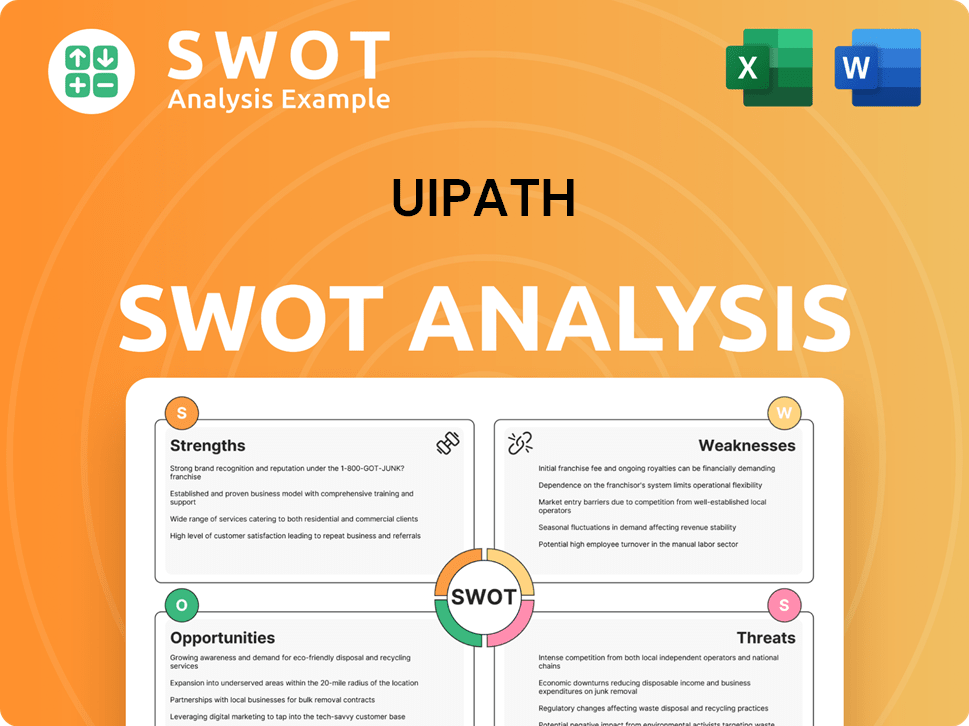
How Has UiPath’s Ownership Changed Over Time?
The ownership journey of the UiPath company showcases a transformation from a privately-held startup to a publicly-traded entity. Initially funded through bootstrapping, UiPath attracted significant venture capital, starting with a $7 million Series A round in 2017 led by Accel. This was followed by a $153 million Series B round in 2018, spearheaded by CapitalG and Accel. Subsequent funding rounds, including a $568 million Series D in 2019 and a $225 million Series E in 2020, brought in investors like Coatue, Alkeon Capital, IVP, and Tiger Global Management, diversifying the UiPath investors base.
The most pivotal moment arrived on April 21, 2021, when UiPath completed its Initial Public Offering (IPO) on the New York Stock Exchange under the ticker 'PATH.' The IPO, priced at $56 per share, raised approximately $1.3 billion and valued the company at over $29 billion. This transition significantly altered the UiPath ownership structure, introducing a wide array of institutional and individual shareholders, and subjecting the company to the scrutiny of public markets. You can explore the Target Market of UiPath to understand more about its growth.
| Event | Date | Impact on Ownership |
|---|---|---|
| Series A Funding | 2017 | Accel becomes a key UiPath investor |
| Series B Funding | 2018 | CapitalG and Accel increase their stake |
| Series D Funding | 2019 | Coatue, Alkeon Capital, IVP, and Tiger Global Management join as investors |
| Series E Funding | 2020 | Further diversification of UiPath investors |
| IPO | April 21, 2021 | Transition to public ownership; Daniel Dines retains a notable stake |
As of early 2025, major institutional investors hold a substantial portion of UiPath's shares. Key institutional shareholders include The Vanguard Group and BlackRock Inc., among others. While the UiPath founder, Daniel Dines, retains a significant stake, the IPO and subsequent market activity have broadened the investor base, impacting company strategy and governance. The UiPath stock symbol is PATH, and understanding the UiPath ownership structure is crucial for anyone interested in the company's financial performance and future prospects.
UiPath's ownership has evolved significantly, from venture capital backing to a public listing.
- The IPO in April 2021 was a major turning point.
- Major institutional investors now hold a significant portion of the shares.
- Daniel Dines, the UiPath founder, still maintains a notable stake.
- Understanding the ownership structure is key to assessing the company's future.
UiPath PESTLE Analysis
- Covers All 6 PESTLE Categories
- No Research Needed – Save Hours of Work
- Built by Experts, Trusted by Consultants
- Instant Download, Ready to Use
- 100% Editable, Fully Customizable
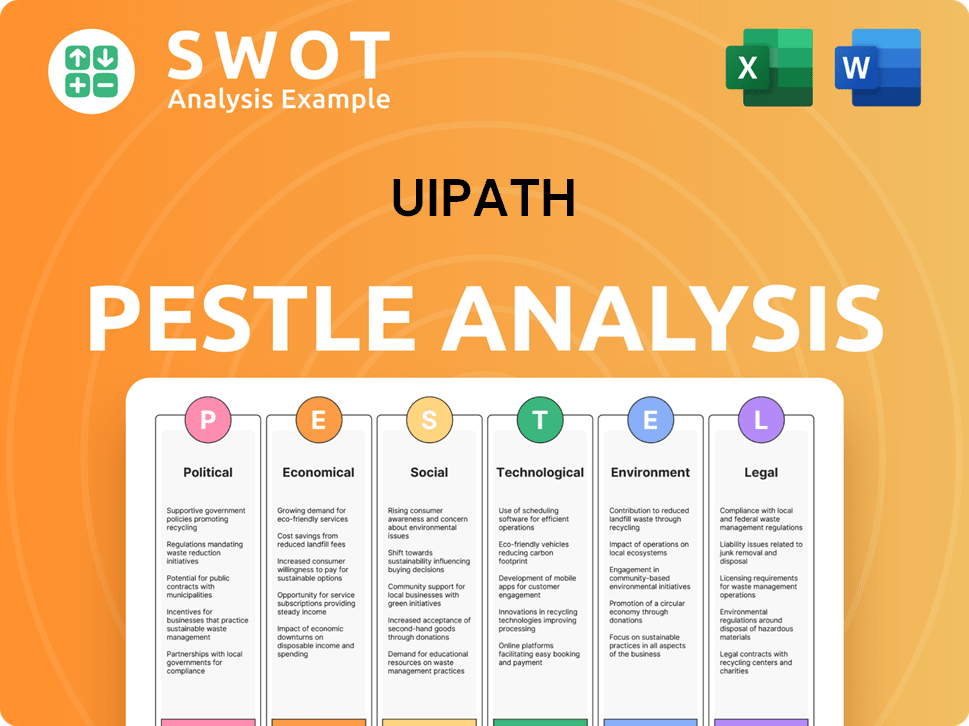
Who Sits on UiPath’s Board?
The Board of Directors of the UiPath company is pivotal in shaping its governance and strategic direction. As of early 2025, the board includes a mix of individuals. Daniel Dines, the co-founder and CEO, serves as Chairman, maintaining his influence. The board also includes representatives from major venture capital firms that invested in the company before its IPO, such as Accel and CapitalG, reflecting the continued involvement of significant shareholders. Independent directors are also present to ensure objective oversight.
The composition of the board ensures that major decisions require consensus among a broad range of shareholders and their representatives, aligning with public company governance standards. This structure helps to maintain a balance between founder influence, major shareholder interests, and independent oversight, contributing to the company's long-term strategic goals and operational effectiveness.
| Board Member | Role | Affiliation |
|---|---|---|
| Daniel Dines | Chairman of the Board, CEO | UiPath Founder |
| Ashim Gupta | Independent Director | Various |
| Rajeev Batra | Independent Director | Various |
UiPath operates with a one-share-one-vote structure for its common stock. Each share of Class A common stock grants one vote on all matters. This standard voting structure promotes equitable distribution of voting power among shareholders. The absence of special voting rights or founder shares supports a balanced approach to corporate governance. While there have been no recent widely publicized proxy battles, the board's composition and voting structure ensure that significant decisions require broad shareholder consensus.
The board of directors includes the co-founder and representatives from major investors. This structure ensures a balance of interests. UiPath uses a one-share-one-vote system, promoting equitable voting power.
- Daniel Dines, co-founder and CEO, is the Chairman of the Board.
- Major investors like Accel and CapitalG have board representation.
- Independent directors provide objective oversight.
- The voting structure is one share, one vote.
UiPath Business Model Canvas
- Complete 9-Block Business Model Canvas
- Effortlessly Communicate Your Business Strategy
- Investor-Ready BMC Format
- 100% Editable and Customizable
- Clear and Structured Layout
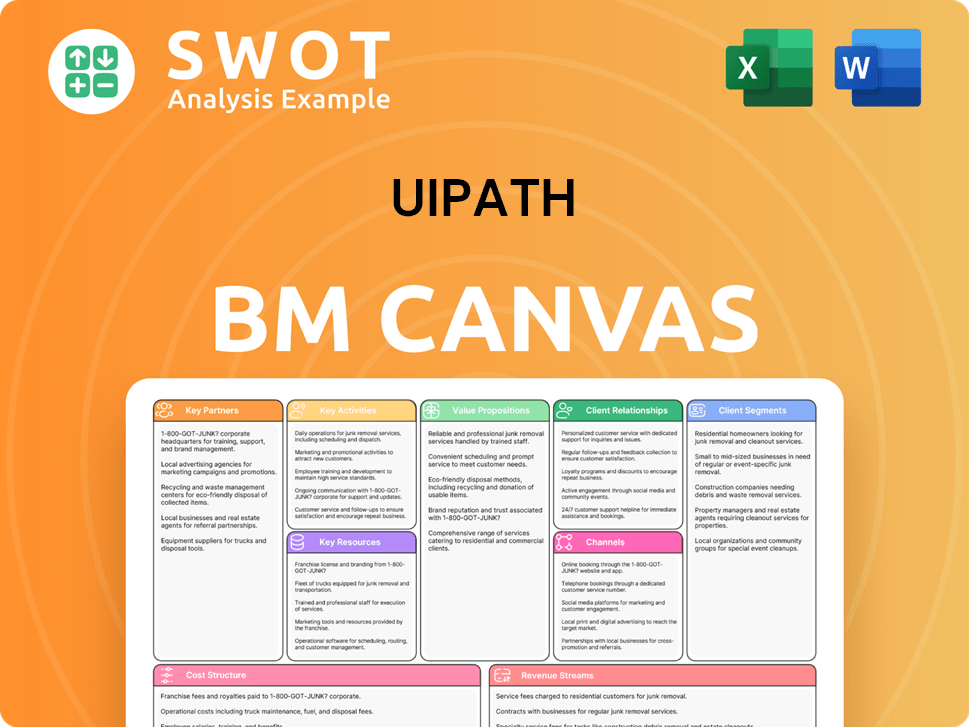
What Recent Changes Have Shaped UiPath’s Ownership Landscape?
The ownership structure of the UiPath company has evolved since its initial public offering (IPO) in April 2021. Market dynamics and the company's performance post-IPO have significantly influenced its ownership profile. Fluctuations in the UiPath stock price have impacted the market value of outstanding shares and the holdings of its investors. The trading activity of shares, driven by company performance and market sentiment, has led to shifts in institutional and individual ownership percentages.
Industry trends also play a role in UiPath's ownership structure. There's a general increase in institutional ownership among technology companies, with large asset managers allocating capital to growth-oriented firms. Major institutional investors like Vanguard and BlackRock continue to hold significant positions. While founder dilution is a natural outcome of multiple funding rounds and the IPO, Daniel Dines, the UiPath founder, remains a substantial individual shareholder, demonstrating ongoing commitment. Understanding the UiPath ownership structure is key for investors.
| Key Ownership Aspects | Details | Impact |
|---|---|---|
| Institutional Ownership | Significant holdings by institutional investors such as Vanguard and BlackRock. | Provides stability and confidence in the company's long-term prospects. |
| Founder Ownership | Daniel Dines, the UiPath founder, maintains a notable individual stake. | Aligns the founder's interests with the company's success. |
| Market Dynamics | UiPath stock performance influences ownership changes. | Reflects investor sentiment and the company's financial health. |
As a publicly traded company, UiPath's ownership will continue to be influenced by market forces and investor sentiment. Strategic moves like mergers and acquisitions could also affect its ownership structure. The company's focus on expanding its AI and automation capabilities is likely to attract further investment, shaping its ownership landscape. For more insights into the company's financial aspects, consider exploring the Revenue Streams & Business Model of UiPath.
The UiPath IPO date was in April 2021. The UiPath share price has fluctuated since its IPO. This has impacted the market capitalization and investor holdings.
Vanguard and BlackRock are among the major UiPath investors. Their significant holdings indicate strong institutional confidence. Institutional ownership provides stability to the stock.
Daniel Dines, the UiPath founder, remains a significant shareholder. His continued involvement reflects a long-term commitment. This aligns with the company's success.
UiPath is focused on AI and automation expansion. This focus is expected to attract further investment. Market forces will continue to shape the UiPath ownership landscape.
UiPath Porter's Five Forces Analysis
- Covers All 5 Competitive Forces in Detail
- Structured for Consultants, Students, and Founders
- 100% Editable in Microsoft Word & Excel
- Instant Digital Download – Use Immediately
- Compatible with Mac & PC – Fully Unlocked
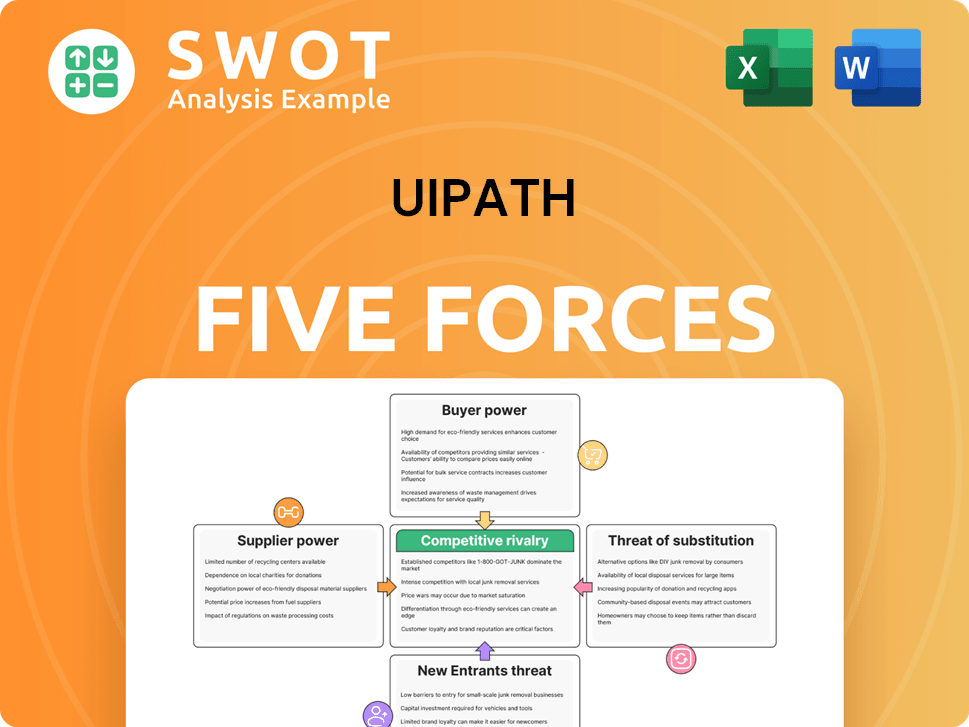
Related Blogs
- What are Mission Vision & Core Values of UiPath Company?
- What is Competitive Landscape of UiPath Company?
- What is Growth Strategy and Future Prospects of UiPath Company?
- How Does UiPath Company Work?
- What is Sales and Marketing Strategy of UiPath Company?
- What is Brief History of UiPath Company?
- What is Customer Demographics and Target Market of UiPath Company?
Disclaimer
All information, articles, and product details provided on this website are for general informational and educational purposes only. We do not claim any ownership over, nor do we intend to infringe upon, any trademarks, copyrights, logos, brand names, or other intellectual property mentioned or depicted on this site. Such intellectual property remains the property of its respective owners, and any references here are made solely for identification or informational purposes, without implying any affiliation, endorsement, or partnership.
We make no representations or warranties, express or implied, regarding the accuracy, completeness, or suitability of any content or products presented. Nothing on this website should be construed as legal, tax, investment, financial, medical, or other professional advice. In addition, no part of this site—including articles or product references—constitutes a solicitation, recommendation, endorsement, advertisement, or offer to buy or sell any securities, franchises, or other financial instruments, particularly in jurisdictions where such activity would be unlawful.
All content is of a general nature and may not address the specific circumstances of any individual or entity. It is not a substitute for professional advice or services. Any actions you take based on the information provided here are strictly at your own risk. You accept full responsibility for any decisions or outcomes arising from your use of this website and agree to release us from any liability in connection with your use of, or reliance upon, the content or products found herein.